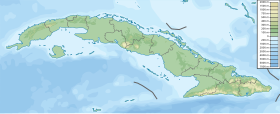Santa Fe La Fe | |
|---|---|
Town | |
 A street in Santa Fe in 1910 | |
 Locator map of Santa Fe (in black) within Isla de la Juventud | |
Location of Santa Fe in Cuba | |
| Coordinates: 21°44′40.9″N82°45′26.1″W / 21.744694°N 82.757250°W | |
| Country | |
| Province | Isla de la Juventud |
| Municipality | Isla de la Juventud |
| Founded | 1809 |
| Elevation | 20 m (70 ft) |
| Time zone | UTC-5 (EST) |
Santa Fe, also named La Fe, [1] is the second largest town on Isla de la Juventud of Cuba.
